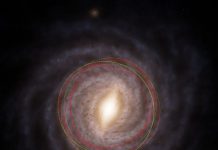
A powerful solar storm that lit up the skies with the aurora borealis last weekend also caused surprising effects deep in the ocean.
New findings from Ocean Networks Canada (ONC), an initiative by the University of Victoria, revealed that the storm affected compasses on subsea observatories on both the west and east coasts of Canada.
These observatories are located as deep as 2.7 kilometers below the ocean surface, making these some of the most remote recordings ever captured.
The most significant shift in the magnetic field was observed at a depth of 25 meters at the Folger Passage subsea site, part of the ONC NEPTUNE cabled observatory off the coast of Vancouver Island.
The compass readings at this depth fluctuated within a range of +30 to -30 degrees.
Geomagnetic disturbances like these can pose risks to power grids, satellite networks, and navigation systems, and they can even affect animals’ navigation abilities.
“The reach of these data recordings kilometers under the ocean surface highlights the magnitude of the solar flare over the past weekend and suggests that the data may be useful for better understanding the geographic extent and intensity of these storms,” says Kate Moran, ONC president and CEO.
The discovery was made during routine data quality checks. ONC uses compasses to orient its Acoustic Doppler Current Profilers (ADCP) instruments, which measure ocean currents. Alex Slonimer, a scientific data specialist at ONC, first noticed the anomaly in late March.
“I looked into whether it was potentially an earthquake, but that didn’t make a lot of sense because the changes in the data were lasting for too long and concurrently at different locations,” Slonimer explains.
He then considered a solar flare, given the recent increased activity of the sun.
The much larger solar storm this past weekend reinforced his observation, with peaks in compass headings closely matching peaks in aurora activity.
Justin Albert, a professor of physics at UVic’s Department of Physics and Astronomy, welcomes these new subsea geomagnetic detections. “The next two years will be the peak of the 11-year solar cycle.
After a decade of relative inactivity, aurora events like this past weekend are likely to become more frequent over the next couple of years, although solar variability makes precise prediction of such events impossible,” says Albert.
“ONC’s network might provide a very helpful additional window into the effects of solar activity on the Earth’s terrestrial magnetism.”
As solar activity increases, ONC’s observations could become crucial for understanding and predicting the impact of solar storms on Earth’s magnetic field, offering valuable insights into these powerful natural phenomena.
Source: University of Victoria.



